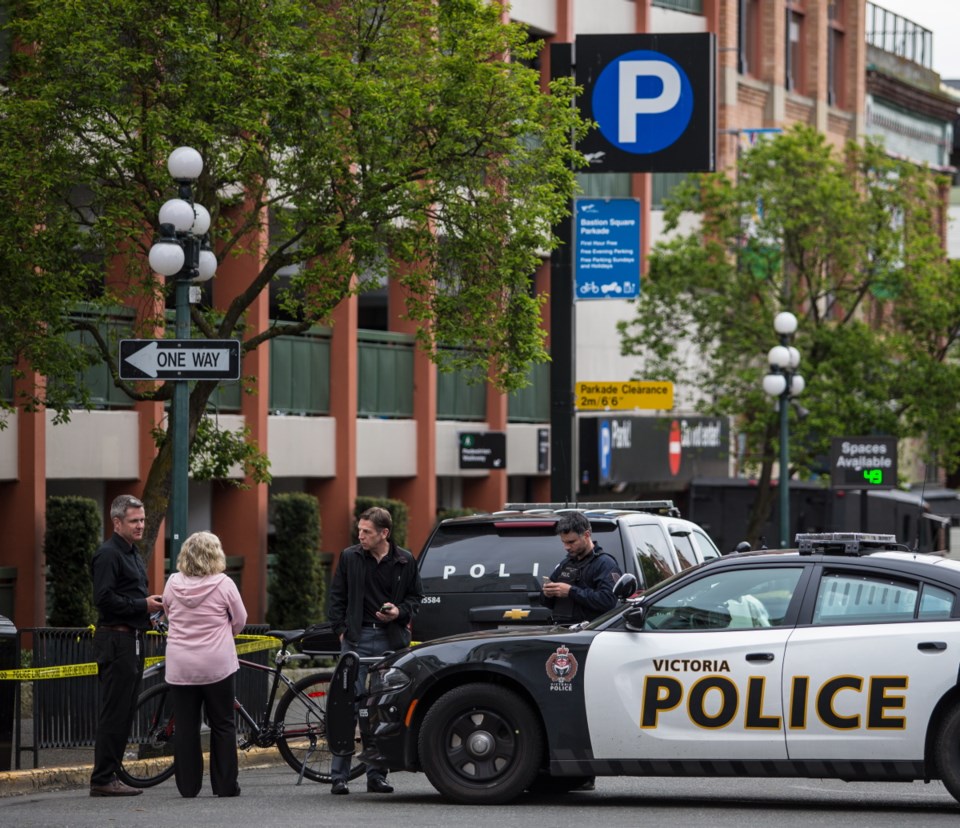Greater Victoria’s patchwork of police departments means the region’s businesses are policed differently. Victoria police often spend their mornings moving campers out of the doorways of downtown shops while suburban departments focus more on proactive community policing.
That has led B.C.’s business community to call on all police forces in B.C. to adopt a common funding and governance model that could lead to a more uniform approach.
A resolution calling on the province to “ensure the provision of effective and adequately resourced police services” by creating a common governance and funding model between B.C. communities was endorsed by about 200 delegates to the B.C. Chamber of Commerce’s grassroots policy building forum in Victoria last weekend.
“From a practical perspective, dividing police resources along municipal borders, especially ones that are adjacent, makes little or no sense,” the resolution said. Each municipality has distinct policing priorities that dictate officers’ patrol duties.
For example, the City of Victoria is regulating marijuana dispensaries, while neighbouring municipalities have worked hard to prevent dispensaries from cropping up in the first place.
Victoria has the vast majority of bars, which means Victoria police spends a lot of time dealing with drunk patrons from across the region.
Victoria Acting Police Chief Del Manak supported the resolution saying that the current model “unfairly places an increased burden on our officers policing the region’s only downtown core,” and leaves Victoria and Esquimalt property owners paying costs that should be shared regionally.
This is an issue that should be explored not only in Greater Victoria, but across the province, Manak said.
“How can we provide a more efficient, cost-effective, integrated policing model across the whole province? It’s not just Victoria and our region where we’re seeing some inequity in terms of the service that’s being provided to each of the communities,” he said.
With Monday’s announcement that the B.C. Greens will support an NDP minority government, Manak said a new government might be more willing to look at the regional policing issue than the B.C. Liberals.
The fractured nature of policing has long been cited as one of the key reasons for amalgamation of the capital region.
Greater Victoria has four separate municipal police forces and three RCMP detachments serving a population of 335,256. Provincewide, 11 independent municipal forces and the RCMP handle policing.
Langford Mayor Stew Young agreed with the idea of a common funding formula. Young said municipalities need more input in negotiating service agreements and if there was to be a single regional force it should be the RCMP.
“I believe that there should be a serious look at it,” Young said.
“The RCMP are already there and they are the largest police force in Canada. It’s easier to move that on than to have a whole bunch of hybrids everywhere.”
Chamber delegates were told that police funding models are not only cumbersome but complex. For example, taxpayers in municipalities with their own police forces pay 100 per cent of policing costs — often accounting for some 30 per cent of municipal property taxes.
Municipalities policed by the RCMP operate under three different provincial funding models. Those with more than 15,000 population pay 90 per cent of the cost, municipalities between 5,000 and 15,000 pay 70 per cent, and municipalities with under 5,000 population pay less than 50 per cent of the cost.
Some broader policing issues have been addressed through the formation of integrated units such as the Vancouver Island Integrated Major Crime Unit or the ICBC-funded Integrated Road Safety Unit.
But the Chamber says the “ad hoc and temporary nature of integrated teams” makes them an unreliable approach to regional policing.
Staff Sgt. Annie Linteau, spokeswoman for RCMP’s E Division, which covers B.C., said the RCMP has worked to implement provincial policing standards in areas such as missing persons investigations, police service dogs, use of force and training.
“Areas like resourcing are discussed and assessed regularly and any increases, decreases, amalgamations or integrations are done through mechanisms outlined within the provincial and municipal police service agreements,” Linteau said.
Esquimalt Mayor Barb Desjardins said local taxpayers would benefit from “something that brought the mechanism closer together in terms of governance as well as consistency [in policing] across the region.”
Meanwhile, a resolution calling on the province for “fair and equitable” property taxes was endorsed by delegates. The resolution asks that the province commission a study to assess municipal property taxation with the goal of developing a more sustainable structure related to value for money.
The chamber has long expressed concern over local governments setting tax rates for non-residential property owners at a higher level (often three and four times as much) — a practice, it says, that bears no resemblance to municipal services used.



